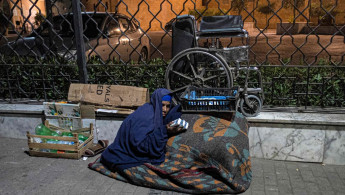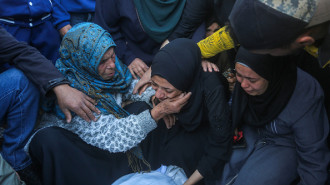Debt storm in MENA: Are Egypt and Tunisia the next Lebanon?
A major debt crisis could be brewing in the Middle East region, threatening systematic default and economic collapse not seen since the start of the Lebanese financial crisis in 2019.
Separate findings this month by both the IMF and Bloomberg economists have identified Egypt, Tunisia, Jordan and Bahrain as critically vulnerable countries that could default on their sovereign debt obligations, with potentially catastrophic implications for their economies and populations.
A Bloomberg update this month on regular rankings of 60 emerging markets by sovereign debt vulnerability placed four Middle Eastern countries in the top quarter: Egypt (2nd), Tunisia (4th), Bahrain (11th) and Jordan (13th). Egypt’s vulnerability assessment was found to be second only to war-torn Ukraine.
Which countries are most vulnerable to a debt crisis?
— Ziad Daoud (@ZiadMDaoud) September 11, 2023
We ranked 60 countries by:
- Public debt
- Interest costs
- Yield on dollar bonds
4 Middle Eastern countries are among the most exposed:
Egypt (2nd)
Tunisia (4th)
Bahrain (11th)
Jordan (13th)
With @sjinlondon, @YvonneMhango pic.twitter.com/0w0xNKTmWw
Earlier in September, the Washington D.C.-based International Monetary Fund (IMF) had also warned about the risk of a debt crisis in Egypt, Tunisia and Jordan, pointing to Lebanon as a cautionary tale after it defaulted in 2020. Urging swift action, the report highlighted that debt levels were unsustainably high, amounting to over 80% of GDP in all three countries.
These levels have left their economies extremely vulnerable to future interest rate hikes as foreign lenders combat high inflation, the IMF added. As these countries struggle to secure financing and shrink large budget deficits, the report warned that a looming economic crisis could also bring political instability if austerity cuts are deepened.
How is vulnerability assessed?
Sovereign debt vulnerability indicates the risk that these countries might default on their debt obligations to lenders. As a percentage of GDP, debt levels were 93% in Egypt, 80% in Tunisia, 125% in Bahrain and 88% in Jordan, according to Bloomberg’s study. Data combined debt-to-GDP ratios with government bond yields (the annual return for investors - the higher the yield, the greater the default risk), and interest payment expenses as a percentage of GDP, to rank the countries.
Though the rankings have changed over the course of the study, Egypt and Tunisia have remained in the top 5 since last year. Both accepted IMF agreements in 2016 and have received several bailouts in the past decade, with Egypt, the region’s most populous nation, considered “too big to fail” and Tunisia gaining importance as the birthplace of the Arab Spring.
Why is this happening now?
These key Arab nations have struggled with severe economic crises over recent years, exacerbated by the COVID-19 pandemic and the resulting loss of tourism revenues and investor confidence. Following the pandemic lockdowns, inflation hit Western economies as they reopened, forcing their central banks to increase interest rates to levels not seen since the 2008 financial crisis. As a result, foreign capital invested in emerging markets started to flow back to the West in search of higher yields - investors withdrew roughly $20 billion from Egypt’s debt markets in 2022.
Last year, Russia’s invasion of Ukraine caused severe disruption to fuel and wheat supply chains, driving up prices, while the tightening of global credit markets saw hiked interest rates in response to global inflation. The fallout was disproportionately felt; Egypt is the world’s largest importer of wheat, mostly from Ukraine, while the countries listed are heavily reliant on shock-vulnerable tourism revenues.
The rising cost of debt servicing amid inflation and interest rate hikes has seriously affected MENA economies. Egypt’s currency inflation - at a high of 39.7% - and Tunisia’s dwindling foreign reserves - dropping to just 91 days’ worth of imports in June - have seen both countries struggle to import basic necessities for essential services such as fuel, electricity, food and medicines.
To save Egypt's economy, the kleptocratic regime must end 👇
— The New Arab (@The_NewArab) January 18, 2023
✍ Sam Hamad https://t.co/M934jQJiW8
Egypt’s interest payments alone are expected to absorb over 50% of government revenues in 2024, according to Fitch, a credit ratings agency. While the probability of a near-term default for such countries is low, it is not unprecedented in the region; Lebanon defaulted on its debt for the first time in 2020. Though Egypt secured an agreement for an IMF bailout in December of last year, Tunisia has yet to do so, with populist President Kais Saied dismissing the offered terms as “foreign diktats”.
What happens next?
Bailouts are difficult to sell to domestic stakeholders because they often require drastic economic reforms, including the privatisation of state-owned assets and reduced public sector wages, alongside further currency devaluations and higher central bank interest rates. State monopolies, an oversized public sector and a stifled private sector, sometimes collectively termed “crony capitalism”, are often blamed for ensuing economic crises.
Fingers are pointed at Egypt’s military, which took power by coup in 2013, or Tunisia’s national labour union, whose approval is vital to Saied’s increasingly authoritarian presidency. Both constituencies are said to wield disproportionate economic leverage. Yet critics retort that previous IMF austerity agreements, such as those signed in 2016, have only aggravated poverty levels by increasing taxes and slashing the state’s subsidies, services and public sector employment, resulting in greater economic and political insecurity.
Blame the flawed economic growth models for MENA's economic crises ⬇
— The New Arab (@The_NewArab) February 11, 2023
✍ @JosephDaher19 https://t.co/LTljhMkAkO
Earlier this year Egypt’s government announced a $2 billion sale of state assets in accordance with its IMF agreement. Though Gulf states bailed out Egypt’s economy last year, prospects of another unconditional Gulf bailout are slim.
Roughly 60% of Egypt’s population is estimated to live below the poverty line. In Tunisia, despite EU funding to control migration outflows, the North African country’s lack of similar geopolitical status has left it with even fewer sources of foreign currency. Shortages of bread, rice, sugar and other basic foodstuffs have grown. Saied’s choice lies between accepting the terms of an IMF bailout and the political instability austerity threatens, or continuing the current spiral of lower credit ratings, higher debt servicing burdens, and greater fiscal strain, until default or collapse.
Global exposure to such debt distress is minimal. Yet with large repayments scheduled next year, a worsening economic crisis could aggravate political tensions, spreading unrest to neighbouring countries or triggering another wave of migration across the Mediterranean. Though neither government is eager to loosen its financial grip, there seems to be little alternative to alleviate the thankless cycle of borrowing, deficit and crisis pursued to date.




 Follow the Middle East's top stories in English at The New Arab on Google News
Follow the Middle East's top stories in English at The New Arab on Google News
![A group of Palestinians, foreign and Israeli activists gather to participated in an olive picking event on the land in the town of Battir, which is under threat of confiscation by Israel in Bethlehem, occupied West Bank on 8 November 2024. [Getty]](/sites/default/files/styles/image_330x185/public/2182930803.jpeg?h=199d8c1f&itok=__0LgGsa)

![People gathered around the rubble of destroyed houses to search for survivors [Getty]](/sites/default/files/styles/image_330x185/public/2024-11/GettyImages-2184733820.jpg?h=199d8c1f&itok=NiM1LO2f)